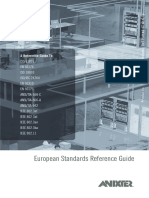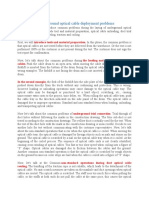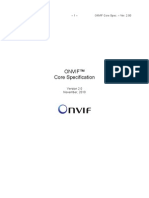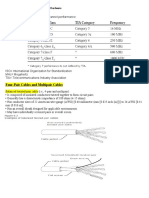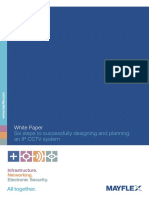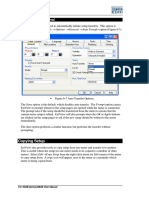Structured Cabling System
Structured Cabling System
Uploaded by
sourjynxCopyright:
Available Formats
Structured Cabling System
Structured Cabling System
Uploaded by
sourjynxCopyright
Available Formats
Share this document
Did you find this document useful?
Is this content inappropriate?
Copyright:
Available Formats
Structured Cabling System
Structured Cabling System
Uploaded by
sourjynxCopyright:
Available Formats
Structured Cabling Systems
A Structured Cabling System (SCS) most simply stated is based on following a standard methodology defined by EIA/TIA 568 specifications when planning and installing network cabling for commercial buildings. The purpose of this standard is to specify a generic telecommunications cabling system for commercial buildings that will support a multi-product, multi-vendor environment. It also provides information that may be used for the design of telecommunications products for commercial enterprises. By following these installation standards and using EIA/TIA compliant cabling products when the network doesnt work they cant blame you! The whole point of this standard that if followed the phone and networking equipment will work as designed. No surprised, no performance issues. Life is good! The EIA/TIA-568 standard includes EIA/TIA-568-B.1 General Requirements, EIA/TIA568-B.2 Copper Cabling Requirements, EIA/TIA-568-B.3 Fiber Cabling Requirements. There are other requirements for very specific issues related to these three but are not needed for this discussion. Similar ISO and IEC specifications exist such as ISO11801 but for our purposes they are similar enough to assume the requirements to be equal. We will summarize each of the three standards separately, with the General Requirements containing the most relevant information. (And I do mean summarize. Between the three documents there are over 300 pages of extremely interesting information (note the sarcasm)). We will also discuss variations of this standard as it relates to the industrial environment. EIA/TIA-568-B.1 General Requirements We already talked about the purpose of this document. Requirements are defined for the following areas of the Telecommunications Cabling System Structure (see Figure 1) 1. 2. 3. 4. 5. 6. Horizontal cabling Backbone cabling Work Area Telecommunications Room Equipment Room Entrance Facilities
This structure is designed to support voice, data, text, video and image services.
Figure 1 Horizontal Cabling The horizontal cabling is the portion of the telecommunications system that extends from the work area to the telecommunications room. The horizontal cabling includes horizontal cables, telecommunications outlet/connectors in the work area, mechanical terminations, and patch cords or jumpers located in the telecommunication room, and may include multi-user telecommunication outlet assemblies and consolidation points. Note the term horizontal is used since typically the cable in this part of the cabling system runs horizontally in the building. Hmm. Makes sense! The telecommunications room should be located on the same floor as the work area served. Note the word should. This means it is preferred but not required. When you see the word shall it means it must be done or the SCS cops will teach you compliance! (Actually there are no SCS cops. We will talk about how to test a SCS later).
Figure 2 illustrates a typical horizontal cabling run. Note bridge taps and splices shall not (remember the word shall?) be installed as part of the copper horizontal cabling. Splitters either. No more than one transition point or consolidation point is allowed (We will talk about these later).
Figure 2 The maximum distance a horizontal run can be is 90 meters (295 feet). The longest a patch cord can be is 5 meters (16 feet). And the longest total length of patch cords on both ends can be 10 meters (32 feet). The cables recognized by EIA/TIA include: 1. Four-pair 100ohm unshielded twisted pair (UTP) or screened twisted pair (ScTP) cables as defined in EIA/TIA-568-B.2 2. Two or more optical fiber multimode cable, either 62.5um or 50/125 um per EIA/TIA 568-B.3. The standard also recommends that there shall be at least 2 connectors for each work area; one Category 3 or higher (we will get to categories soon) and the other number 1 or 2 above to support LAN services.
Backbone Cabling The function of the backbone cabling is to provide interconnection between telecommunication rooms, equipment rooms, main terminal space and entrance facilities (did I forget the kitchen sink? Hey everything is being networked today.) It includes the backbone cables, intermediate and main cross-connects, mechanical terminations, and the patch cords or jumpers used for backbone to backbone cross-connection. It also includes cabling between buildings. The backbone cabling shall use the hierarchical star topology as illustrated in Figure 3. From the horizontal cross-connect there shall be no more the one additional cross-connect to reach the main cross-connect.
Figure 3 The cables used depend on the application Figure 4 list the maximum distance requirements for the various cable runs. Note that the distances listed for twisted pair cable is for supporting telephone use. To support higher network speeds the 90 meter UTP length still applies back to the main cross-connect.
Figure 4 In the main cross-connect, jumper or patch cord lengths should not (note should not shall so no beatings if you violate this one, though you could get blamed if something doesnt work!) exceed 20 m (66 ft). Same for the intermediate cross-connect. The length of the cable used to connect telecommunications equipment directly to the main or intermediate cross-connect should not exceed 30 m (98 ft). Work Area The work area includes the telecommunications outlet/connector end of the horizontal cabling system to the work station equipment (i.e. PC, PLC, etc.). The work area outlet is either in the form of a faceplate or a box. Its primary purpose is to hold the connector or modular jack. Per the standard each 4-pair cable shall be terminated in an eight-position modular jack per EIA/TIA-568-B.2 and IEC 60603-7. There are two cabling schemes approved, T568A and T568B (see figure 5). The US Government only recognizes T568A, in case you wanted to know. The most common however is T568B as it was the standard scheme used by AT&T during their golden years as a monopoly.
568A Figure 5
568B
For fiber cabling these shall be terminated to a duplex optical fiber connector meeting the requirements of EIA/TIA-568-B.3. The SC connector is preferred by EIA/TIA but others can be used such as the ST and various small form factor connectors. As already stated the maximum length allowed for the patch cord in the work area is 5 m (16 ft). (Just stating it again in case you werent paying attention the first time.) MUTOA (Multi-user telecommunications outlet assembly) Remember that I just told you the maximum length allowed for the patch cord in the work area is 5 meters (hey you were paying attention)? Well there is an exception and it is when you use a MUTOA (I am not typing this out twice). This was added to the standard to address the growing use of modular furniture in the commercial office. It provides a more flexible wiring means that facilitates changes easier. See figure 6. It also complicates things a bit, but as long as you follow the guidelines of Figure 7 you will stay compliant (and avoid the SCS cops, blame, etc.) It is limited to serving a maximum of 12 work areas. It shall also be located in a fully accessible permanent location, and not in ceilings.
Figure 6
Figure 7 Consolidation Point One other twist in horizontal cabling includes the Consolidation Point. It is an interconnection point within the horizontal cabling using the appropriate compliant connecting hardware, including the requirements of being rated for at least 200 cycles of connections. It also cannot be located within 15 m (49 ft) of telecommunications room as it can cause cabling performance degradation due to reflections. The Consolidation Point may be useful when reconfiguration is frequent, but not so frequent as to require the flexibility of the MUTOA. The Telecommunications Room The primary function of a telecommunications room is the termination of horizontal and backbone cable to compatible connecting hardware. All connections between horizontal and backbone cables shall be cross-connections. Equipment cables/cords that extend a single port appearance may connected through an interconnect. So what is the difference between a cross-connect and an interconnect? Glad you asked! Figure 8 shows the difference. When terminating a small amount of cables (less than 100) an interconnect is fine. As the amount of connections grow the cross-connect provides better overall cable management.
Figure 8 Equipment rooms are similar to Telecommunication Rooms except they typical house more variety or complex equipment. Entrance Facility The Entrance Facility consist of cables, connecting hardware, protection devices, and other equipment needed to connect the outside plant facilities to the premise cabling. It is beyond the scope of this paper to address this. Cabling Installation Requirements Just as import as choosing compliant connecting hardware and following the installation design guidelines of these standards is installation practices. Even the best cable and components improperly installed will not work, or at least not to its full potential. Some of the most important installation requirements for UTP in order of importance include: 1. Cable pair twist shall be maintained to within 13 mm (0.5 in) from the point of termination. UTP gets a great deal of its performance attributes from the twist of the paired cables. It does not take much untwist to cause a measurable drop in performance. This is by far the most important factor for installation factors. Treat shall as shall, must, do not deviate or whatever else you want to call it but do meet this recommendation. 2. While it may be obvious all cables shall be terminated with connecting hardware of the same category or higher. Terminating Category 5e cable on Cat 3 connectors will definitely hurt cabling performance. The same goes for the use of patch cords.
3. The minimum bend radius for horizontal UTP cable shall be four times the cable diameter, or in other words avoid sharp bends. To emphasize the importance of untwist the primary reason for this recommendation is that sharper bends tend to straighten out the twist in the pairs! There is no minimum bend radius for patch cables at this time. 4. Watch how hard you pull the cable. The maximum pulling tension of 4 pair 24 AWG UTP cable shall be 110 N (25lbf). Can you guess why this recommendation exists? Thats right, be pulling too hard you untwist the pairs effecting performance!! 5. Use common sense when laying out the cable. For example do not run the horizontal cable right over fluorescent lights and wonder why you are picking up stray noise! For fiber the following applies in order of priority: 1. Do not untwist . Just seeing if you were paying attention. Fiber is the opposite. Twist it and it will break. The bend radius is the most important factor. Bend it too sharp and may not only degrade the signal but break and lose all the signal. The bend radius for 2 and 4 horizontal optical fiber cable shall not be less than 25 mm (1 in) under no load conditions. For backbone cable the bend radius shall not be less than 10 times the cable diameter unless otherwise recommended by the manufacture. 2. Proper connector termination is absolutely a must. The quality of the polish greatly determines the performance of the cabling system. There are many field terminable connectors that include a pre-polished stub that all you do is butt up the fiber cable to and terminate. It is not quite that easy but it is sure beats having to field polish the termination in generally less than ideal conditions. 3. And again use common sense keeping in mind the need to avoid sharp bends in the cable. Testing OK so you have bought all the right stuff and followed all the design recommendations and installed it perfectly, how do you test it? The exact test criteria is set out in great detail in the standards for both copper and fiber cabling and we will not go in great detail here on that. However you dont need to worry about these as testers exists that are certified to meet the standards and you just need to learn how to use them. They will tell you whether they meet the category of performance you are testing for, and depending on their features can help you isolate the problem. There are two test used in the field to test a copper system, Channel test (Figure 9) and a Permanent Link test (Figure 10). The Channel test includes all components of the horizontal cabling system including the patch cords. This is the better test regarding actual performance. The Link test exists as there are many times cabling systems is installed before any office equipment is moved in or telecommunication room equipment is installed. This provides a test for the installer or contractor to verify the performance of the installation lacking the equipment patch cords.
Figure 9
Figure 10
For fiber the test are just as straight forward providing you have a certified tester.
What are Categories for UTP cabling systems? So what is Category 3, 5, 5e and 6? And why should I care? The recognized categories of twisted pair cable by EIA/TIA 568 are: 1. Category 3: This designation applies to 100 ohm cable whose transmission characteristics are specified up to 16 MHz. 2. Category 5e: This designation applies to 100 ohm cable whose transmission characteristics are specified up to 100 MHz 3. Category 6: This designation applies to 100 ohm cable whose transmission characteristics are specified up to 250 MHz Cable, Patch Cords, and Connecting Hardware are all rated one of these categories. It is critical to note that rating of a cabling system is determined by its lowest rated component! If you have Cat 6 cable and connecting hardware everywhere but use a Cat 3 patch cord, you have a Cat 3 system. Dont do this. For practical application Category 3 support 10BaseT Ethernet networks. Category 5e supports 10BaseT, 100BaseT and 1000BaseT (yes it really supports 1 gigabit LANs over UTP). Category 6 supports everything Cat5e and will support 10GBaseT or 10Gigabit LANs Industrial Considerations So what changes for the industrial environment related to the SCS? Actually very little. All the same standards apply including installation requirements and test requirements. And if you mount everything inside NEMA rated enclosures then nothing changes at all. However if you want to plug into the network from outside the enclosure there is a new connector style available called an Industrial RJ45. The specifications are being developed by EIA/TIA TR-42.9 committee and ODVA for Ethernet IP applications and are nearly complete. This new connector interface, see Figure 11, contains at its core the 8 pin modular plug and connector specified in EIA/TIA 568. It is however surrounded with other mechanical connections to seal it against the environment with ratings such as IP67.
Figure 11
For an explanation of the IP rating system see Figure 12 below. IP Index
1st Digit 0 1 Degree of Protection from Dust No protection Protection against solid foreign objects of 50 mm in diameter and greater Protection against solid foreign objects of 12 mm in diameter and greater Protection against solid foreign objects of 2.5 mm in diameter and greater Protection against solid foreign objects of 1.0 mm in diameter and greater Protection against dust. Limited to ingress (no harmful deposits) Total protection against dust. 2nd Digit 0 1 Degree of Protection from Water No protection Protection against vertical water spray Protection against direct sprays of water up to 15 degrees from the vertical Protection against direct sprays of water up to 60 degrees from the vertical Protection from splashed water out from all directions Protection from splashed water out of a nozzle from all directions Protection from temporary flooding Protection from temporary immersion Protection from water pressure - water tight
3 4 5 6
3 4 5 6 7 8
Figure 12 Conclusions 1. Structured Cabling in using an organized approach to the design and installation of the cabling based on EIA/TIA 568 specifications. 2. Critical issues to keep in mind include a. Use EIA/TIA compliant cables, patch cords and connecting hardware b. Do not exceed the 90 m horizontal cable length limits c. Use the correct performance Category components to match the application. B&B recommends Cat 5e for UTP as it will support up to 1000 BaseT LANs. d. Do not untwist UTP, do not over bend Fiber e. When using fiber look into the pre-terminated stub connectors on the market. f. To know if you did it right there are testers designed just for this application for both copper cabling and fiber cabling. g. If you want more details buy the EIA/TIA specifications and read them yourself. 3. There is an industrial variation of the modular connector interface with an IP67 rating for tough industrial environments. The standard is still pending so interoperability may be an issue if you mix and match components from multiple vendors.
You might also like
- SCS Specification Document - Revised - MAY 2019Document32 pagesSCS Specification Document - Revised - MAY 2019AhrariMustafaNo ratings yet
- Fiber Optic TestingDocument18 pagesFiber Optic TestingViệt Đặng XuânNo ratings yet
- 2 Mark Questions With AnswersDocument3 pages2 Mark Questions With AnswersMonica Purushothaman50% (2)
- Chapter 2 - Groundwater Movements - Part 5 PDFDocument53 pagesChapter 2 - Groundwater Movements - Part 5 PDFTrisha Veronica Candelaria AVENGOZANo ratings yet
- 01-E2aaf-1 Ic 10Document12 pages01-E2aaf-1 Ic 10Blaze123xNo ratings yet
- Deep Beam Design Based On ACI 318-14: Input DataDocument3 pagesDeep Beam Design Based On ACI 318-14: Input DataahmedhusseinkamelNo ratings yet
- Premises Wiring - Cable ManagementDocument25 pagesPremises Wiring - Cable Managementfarooq_bhattiNo ratings yet
- Ntroduction To Structured CablingDocument5 pagesNtroduction To Structured CablingIT TG CAPNo ratings yet
- Design Planning 3M VolitionDocument179 pagesDesign Planning 3M VolitionMarian Ilie0% (1)
- Telecoms - NetworkingsDocument17 pagesTelecoms - NetworkingsojnaiduNo ratings yet
- 12H0009X00 Anixter Standards Reference Guide EMEA en UKDocument95 pages12H0009X00 Anixter Standards Reference Guide EMEA en UKMarwa Ismail KamelNo ratings yet
- Anixter Installation Pocket Reference Guide BOOK WC EN US PDFDocument120 pagesAnixter Installation Pocket Reference Guide BOOK WC EN US PDFJose Gregorio SanchezNo ratings yet
- Structured CablingRFC - Response - Quantitization and Costing AaronODocument6 pagesStructured CablingRFC - Response - Quantitization and Costing AaronOAaron SemoNo ratings yet
- Information Communication Technology (ICT) Infrastructure Specifications Manual (Local Area Networks and Data Cabling)Document92 pagesInformation Communication Technology (ICT) Infrastructure Specifications Manual (Local Area Networks and Data Cabling)SteggosNo ratings yet
- Telecom Standards Manual PDFDocument120 pagesTelecom Standards Manual PDFDivya Jandhyala100% (1)
- TIA 568 C SeriesDocument44 pagesTIA 568 C SeriesMALCANTARAMNo ratings yet
- ODN OSP ConstructionDocument16 pagesODN OSP ConstructiongurungeNo ratings yet
- لستة موردين مكتب شاكر - 2022Document92 pagesلستة موردين مكتب شاكر - 2022eng.samarsayed91No ratings yet
- Passive Optical NetworksDocument94 pagesPassive Optical NetworksNguyen KhaNo ratings yet
- IP Telephony Business CaseDocument7 pagesIP Telephony Business CaseSaeed KhanNo ratings yet
- EST4 Overview Data Sheet Final 8819Document6 pagesEST4 Overview Data Sheet Final 8819RaviNo ratings yet
- 03 Cat6ADocument20 pages03 Cat6ASudheer EgadeNo ratings yet
- Cara Nak Pasang Wayar Cats Eye Utk NetworkDocument15 pagesCara Nak Pasang Wayar Cats Eye Utk NetworkKrull Hzm100% (1)
- Onvif Core Spec 20Document355 pagesOnvif Core Spec 20Phan Ba Hiep100% (1)
- Chapter 6 ITS Cables and Connecting HardwareDocument20 pagesChapter 6 ITS Cables and Connecting HardwareQuaid JanNo ratings yet
- IECEP Rizal Structured Cabling 1st Seminar 2019 PDFDocument61 pagesIECEP Rizal Structured Cabling 1st Seminar 2019 PDFwillardo c. mesaNo ratings yet
- Chapter 5 Horizontal Distribution SystemsDocument27 pagesChapter 5 Horizontal Distribution SystemsQuaid JanNo ratings yet
- Communications Cabling Manual Communications Cabling HandbookDocument6 pagesCommunications Cabling Manual Communications Cabling HandbookMohammed KhalidNo ratings yet
- CATV Lodget HotelDocument25 pagesCATV Lodget HotelabrahamNo ratings yet
- Cable Tray LadderDocument37 pagesCable Tray LadderrocketvtNo ratings yet
- ANSI-TIA-606-B - The Updated Labeling Standard - Todd Fries - HellermannTytonDocument72 pagesANSI-TIA-606-B - The Updated Labeling Standard - Todd Fries - HellermannTytonBushido Schrödinger100% (1)
- Organizational ChartDocument1 pageOrganizational ChartDM Harder TradingNo ratings yet
- Optical Distribution FramesDocument28 pagesOptical Distribution FramesRoni SharmaNo ratings yet
- Cable Tray - V-Sch-64002-Common-002 - 1Document38 pagesCable Tray - V-Sch-64002-Common-002 - 1Isaias TabordaNo ratings yet
- No Item Description Brand/Type HardwareDocument6 pagesNo Item Description Brand/Type HardwareRenaldi RusjdiNo ratings yet
- Maxis Fiber InstallationDocument15 pagesMaxis Fiber InstallationMuhamad Ashraff100% (1)
- LAN CableDocument7 pagesLAN CableBhavesh KeraliaNo ratings yet
- Guidelines For Fiber Optic Cable InstallationDocument14 pagesGuidelines For Fiber Optic Cable InstallationBrielle ManuelNo ratings yet
- Standards OverviewDocument12 pagesStandards Overviewhongnh-1No ratings yet
- Cat6 U Utp Cable 1427071Document2 pagesCat6 U Utp Cable 1427071diepchidungNo ratings yet
- 04 Web Fiber Present enDocument34 pages04 Web Fiber Present enmfarouk1No ratings yet
- Telecomunications Cabling Specification v5Document77 pagesTelecomunications Cabling Specification v5Tamer Elmaghraby100% (1)
- Vlan Practice Lab Setup On Packet TracerDocument4 pagesVlan Practice Lab Setup On Packet TracervyarthNo ratings yet
- Codigos de Partes PanduitDocument696 pagesCodigos de Partes PanduitrafcacNo ratings yet
- Structured Cabling 101 ADocument20 pagesStructured Cabling 101 AtwinspikaNo ratings yet
- FS Hotel Jeddah Corniche - IPTV VOD System - Technical SpecificationDocument21 pagesFS Hotel Jeddah Corniche - IPTV VOD System - Technical SpecificationMahmoud MaghrpyNo ratings yet
- Lab 3 Full Fiber OpticDocument3 pagesLab 3 Full Fiber OpticAmeerul SalimNo ratings yet
- Ansi Tia Standards CompressDocument33 pagesAnsi Tia Standards CompressNguyễn Văn CườngNo ratings yet
- D-Link Copper Product CatalogDocument71 pagesD-Link Copper Product CatalogsivaguruNo ratings yet
- Fiber Arch For Rural FTTX WPDocument5 pagesFiber Arch For Rural FTTX WPVulpe FlorianNo ratings yet
- ResumeDocument7 pagesResumedpprasad2No ratings yet
- Lesson 7 - Structured Cabling SystemsDocument21 pagesLesson 7 - Structured Cabling Systemsjackstone saitotiNo ratings yet
- Set - Top Box (STB)Document20 pagesSet - Top Box (STB)AbinayaNo ratings yet
- Building Telecommunications Infrastructure RequirementsDocument16 pagesBuilding Telecommunications Infrastructure Requirementsestoy estoyNo ratings yet
- Mayflex - WhitePaper - Six Steps To Successfully Designing and Planning An IP CCTV SystemDocument6 pagesMayflex - WhitePaper - Six Steps To Successfully Designing and Planning An IP CCTV Systemme1111No ratings yet
- Buried Installation of Optic Fiber Cable: Application NotesDocument19 pagesBuried Installation of Optic Fiber Cable: Application NotesAli AbdulaleemNo ratings yet
- Ctrl-Eng Ethernet EssentialsDocument8 pagesCtrl-Eng Ethernet EssentialsCyrix.OneNo ratings yet
- Unit: Structured Cabling: Describe The Importance of Designing and Installing Cables Properly PlanningDocument24 pagesUnit: Structured Cabling: Describe The Importance of Designing and Installing Cables Properly PlanningMarilyn Farillon - LeysaNo ratings yet
- Lecture 4 Network - CablingDocument42 pagesLecture 4 Network - CablingENOCK MONGARENo ratings yet
- Guide ISO 11801 2nd PDFDocument24 pagesGuide ISO 11801 2nd PDFthepimpoNo ratings yet
- TIAEIA568 StandardDocument12 pagesTIAEIA568 StandardrdgajanayakeNo ratings yet
- Jobs at Technical University-1Document3 pagesJobs at Technical University-1Engr AHmed Ali DallNo ratings yet
- Bcom Notes MisDocument101 pagesBcom Notes Missukrati.m25No ratings yet
- Compressed Air Part2Document14 pagesCompressed Air Part2HmidaNo ratings yet
- Air-Winch Manual PDFDocument56 pagesAir-Winch Manual PDFQuyet Nguyen0% (1)
- Desktop GPU Performance Hierarchy Table PDFDocument3 pagesDesktop GPU Performance Hierarchy Table PDFCiberLaNetaNo ratings yet
- Hua-Dong: Yao, PHDDocument2 pagesHua-Dong: Yao, PHDEmmanuel AeroEng ZingapetaNo ratings yet
- Aquaplaning, Road Surface &..Document2 pagesAquaplaning, Road Surface &..Nico DwijayaNo ratings yet
- Design Project1Document19 pagesDesign Project1Syed Munawar Ali100% (1)
- Research Design: Unit-IIIDocument34 pagesResearch Design: Unit-IIIAshok Kumar UppariNo ratings yet
- Lecture 3 (Psychometric Chart) - Psychometric ChartDocument7 pagesLecture 3 (Psychometric Chart) - Psychometric ChartbalsamNo ratings yet
- Power Plant Engineering Fuel and Combustion System Chpter 3Document79 pagesPower Plant Engineering Fuel and Combustion System Chpter 3mussietilahun591No ratings yet
- The Hydrodynamics Performance of Aquaculture Fishing Vessel in Variation of Deadrise Angle and SponsonDocument10 pagesThe Hydrodynamics Performance of Aquaculture Fishing Vessel in Variation of Deadrise Angle and SponsonTJPRC PublicationsNo ratings yet
- Fast Fourier Transform For Dummies PDFDocument2 pagesFast Fourier Transform For Dummies PDFJutamasNo ratings yet
- 159 PDFDocument74 pages159 PDFatheb12345No ratings yet
- Tutorial Sheet 2Document2 pagesTutorial Sheet 2Shivansh JangidNo ratings yet
- CV Veab Heat Tech GBDocument18 pagesCV Veab Heat Tech GBRyan SaviNo ratings yet
- How To Install Ubuntu LinuxDocument10 pagesHow To Install Ubuntu LinuxTrisna Agung MahendraNo ratings yet
- Gilson Briggssnöslunga 8 HKDocument33 pagesGilson Briggssnöslunga 8 HKPeter LingmanNo ratings yet
- SmartDC V100R003C00 Commissioning Guide (For ECC800-Pro)Document197 pagesSmartDC V100R003C00 Commissioning Guide (For ECC800-Pro)Muana TumitanguaNo ratings yet
- FMEA-Revised Veera Oct11e PDFDocument64 pagesFMEA-Revised Veera Oct11e PDFaman_ranhotraNo ratings yet
- Method Statement For Pipe Support Fabrication and Installation 6423dp420 00 0030000 Rev01 PDFDocument21 pagesMethod Statement For Pipe Support Fabrication and Installation 6423dp420 00 0030000 Rev01 PDFfurkanNo ratings yet
- Title 1 Inventory 2021-2022Document57 pagesTitle 1 Inventory 2021-2022bookwormjoeyNo ratings yet
- 1تقرير الوزن النوعي للتربهDocument4 pages1تقرير الوزن النوعي للتربهghaithghaith020No ratings yet
- Gas Engines For DatacentersDocument24 pagesGas Engines For DatacentersbrockNo ratings yet
- BWPX 307TGD-71 - Instruction Book - 2010Document218 pagesBWPX 307TGD-71 - Instruction Book - 2010Centrifugal SeparatorNo ratings yet










